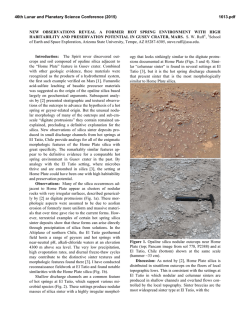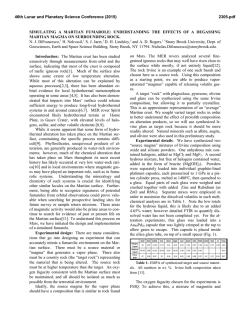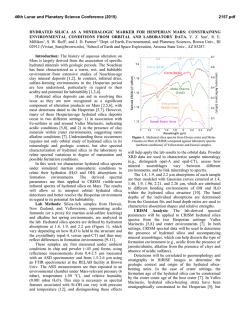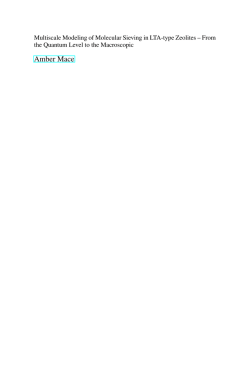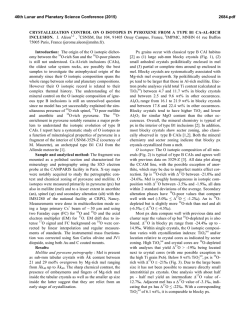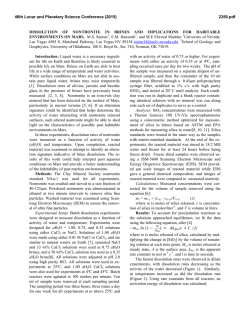
Formation and characterization of inorganic membranes
MATERIALS RESEARCH SOCIETY SYMPOSIUM PROCEEDINGS
V O L U M E 121
Better Ceramics Through Chemistry III
S y m p o s i u m held April 5-8, 1988, Reno, Nevada, U . S . A .
EDITORS:
C. Jeffrey Brinker
Sandia National Laboratories, Albuquerque, New Mexico, U.S.A.
David E. Clark
University of Florida, Gainesville, Florida, U.S.A.
Donald R. Ulrich
Air Force Office of Scientific Research, Washington, D . C . , U.S.A.
I M I R I S I
I—J^^LJ
M
A
T
E
R
I
A
L
S
RESEARCH SOCIETY
Pittsburgh, Pennsylvania
1988
Contents
PREFACE
xv
MATERIALS RESEARCH SOCIETY SYMPOSIUM PROCEEDINGS
xvi
PART I - Sol-Gel Chemistry I : Silicates
* MOLECULAR GROWTH PATHWAYS IN SILICA SOL-GEL POLYMERIZATION
W. G. Klemperer and S. D. Ramamurthi
1
* STRUCTURAL CHARACTERIZATION OF POLYSILICATE INTERMEDIATES
FORMED DURING SOL-GEL POLYMERIZATION
W. G. Klemperer, V. V. Mainz, S. D. Ramamurthi and F. S. Rosenberg
15
29
* SOL-GEL KINETICS: S i N M R A N D A STATISTICAL REACTION MODEL
R. A. Assink and B. D. Kay
25
KINETICS STUDY OF THE ACIDIC C A T A L Y Z E D POLYMERIZATION OF
TETRAETHOXYSILANE BY ™S\ N M R
J-C Pouxviel and J. P. Boilot
37
BRANCHING THEORY I N SOL-GEL PROCESSING
N . A. Peppas, A. B. Scranton, A. H . Tsou and D. E. Edwards
43
* NMR CHARACTERIZATION OF PRECURSORS TO C H E M I C A L L Y DERIVED
CERAMICS
J. D. Basil and C-C. L i n
49
* STUDIES OF THE HYDROLYSIS A N D POLYMERIZATION OF SILICON
ALKOXIDES IN BASIC ALCOHOL SOLUTIONS
G. H . Bogush, G. L . Dickstein, P. Lee (K. C.) and C. F. Zukoski, IV
57
THE INFLUENCE OF A L K A L I M E T A L HYDROXIDES ON SILICA
CONDENSATION RATES: THE ROLE OF ION PAIRING
Α. V. McCormick, A. T. Bell and C. J. Radke
67
RHEOLOGICA L MONITORING OF GELATION KINETICS OF SILICA SOLS
S. A. Khan, E. M . Rabinovich, R. K . Prud'homme, M . J. Sammon and N . J. Kopylov...
73
PART I I - Sol-Gel Chemistry I I : Non-Silicates
* POLYMETALLIC ALKOXIDES - PRECURSORS FOR CERAMICS
R. C. Mehrotra
81
* SYNTHESIS A N D CHARACTERIZATION OF V A N A D I U M OXIDE GELS FROM
A L K O X Y - V A N A D A T E PRECURSORS
C. Sanchez, M . Nabavi and F. Taulelle
93
R A M A N A N D NMR STUDIES OF HYDROUS SODIUM TITANATES
B. C. Bunker, C.H.F. Peden, D. R. Tallant, S. L . Martinez and G. L . Turner
105
ELECTROCHEMICAL SYNTHESIS OF ZIRCONIA
J. A. Switzer and R. J. Phillips
Ill
* Invited Paper
ν
SOL-TO-GEL TRANSITION I N REVERSED MICELLES MICROEMULSIONS I .
A NEW ROUTE TO PRODUCE MONOLITHIC M E T A L - O R G A N I C DERIVED
GELS
C. Guizard, M . Stitou, A . Larbot, L . Cot and J. Rouviere
115
GROWTH A N D STRUCTURE OF ALUMINO-SILICATE POLYMERS
J. P. Boilot, J-C. Pouxviel, A. Dauger and A. Wright
121
ORGANOMETALLIC APPROACHES TO CERAMIC MATERIALS
D. C. Hrncir
127
INVESTIGATION OF THE EFFECT OF D I M E T H Y L F O R M A M I D E ADDITION
ON A L U M I N A SOL-GEL FORMATION BY " A L NMR A N D RHEOLOGY
MEASUREMENTS
L. F. Nazar, L. C. Klein and D. Napier
133
THE GEL ROUTE TO Y T T R I U M OXIDE
F. Ribot, C. Sanchez and J. Livage
139
CHEMICAL A N D PHYSICAL PRINCIPLES OF PROCESSING T H A T AFFECT
MICROSTRUCTURE OF A l 0 - Z r 0 COMPOSITES
A. Bleier and G. Westmoreland
145
2
3
2
PART I I I - Structure/Property Relationships
M A T H E M A T I C A L MODELING OF THE STRUCTURES A N D B U L K M O D U L I
OF TX Q U A R T Z A N D CRISTOBALITE STRUCTURE-TYPES,
Τ = C,Si,Ge A N D X = 0,S
G. V . Gibbs, Μ. B. Boisen, Jr., R. T. Downs and A . C. Lasaga
155
IONIC PROPERTIES OF V A N A D I U M PENTOXIDE GELS
J. Livage, P. Barboux, J. C. Badot and N . Baffier
167
SYNERESIS I N SILICA GEL
G. W. Scherer
179
ADHESION OF HYDRATED SILICATE FILMS
T. A. Michalske and K . D. Keefer
187
CRYSTALLIZATION BEHAVIOR OF C H E M I C A L L Y PREPARED A N D
RAPIDLY SOLIDIFIED PbTiO
R. W. Schwartz and D. A. Payne
199
COMPARISON BETWEEN THE SOL-GEL PROCESSES OF ZIRCONIA A N D
THOSE OF A L U M I N A
A. C. Pierre and D. R. Uhlmann
207
STRUCTURAL ORGANIZATION OF E A R L Y GELS A N D PRECIPITATES OF
CHEMICALLY BONDED CERAMICS
W. B. White, D. J. Vesper and J. Kraus
213
CORRELATIONS BETWEEN PROCESSING PARAMETERS,
ULTRASTRUCTURE, A N D STRENGTH OF GEL-SILICA
J. K . West, R. Nikles and G. Latorre
219
2
s
Invited Paper
vi
PART I V - Powder Synthesis/Processing
* INORGANIC GELS WITH NANOMETER-SIZED PARTICLES
B. J. Tarasevich, J. L i u , M . Sarikaya and I . A. Aksay
225
A L U M I N A POWDERS FROM A L U M I N U M A L K O X I D E
A. Ayral, J. Phalippou and J. C. Droguet
239
MULTI-PHASIC NANOCOMPOSITE SOL-GEL PROCESSING OF CORDIERITE
A . Kazakos-Kijowski, S. Komarneni and R. Roy
245
CONTROLLED MORPHOLOGY I N ELECTRONIC CERAMIC POWDER
PREPARATION
R. Legros, R. Metz, J. P. Caff in, A. Lagrange and A. Rousset
251
SPHERICAL ZIRCONIA PARTICLES V I A ELECTROSTATIC A T O M I Z A T I O N :
FABRICATION A N D SINTERING CHARACTERISTICS
Ε. B. Slamovich and F. F. Lange
257
EFFECTS OF TEMPERATURE A N D REACTANT CONCENTRATION ON
PROPERTIES OF FINE T i 0 PARTICLES PREPARED BY VAPOR-PHASE
HYDROLYSIS OF T I T A N I U M TETRAISOPROPOXIDE
F. Kirkbir and H . Komiyama
263
PREPARATION OF STOICHIOMETRIC M T i O POWDERS ( M ' = Ba, Sr, Ca)
FROM CATECHOLATE COMPLEXES
N . J. A l i , J. Bultitude, L . A. Xue and S. J. Milne
269
2
s
SOL-GEL SYNTHESIS A N D CHARACTERIZATION OF B a T i 0 A N D B a T i 0
POWDERS
P. P. Phule and S. H . Risbud
4
9
3
275
PREPARATION OF BaTiO BY SOL-GEL-PROCESSING
G. Tomandl, H . Rosen and A. Stiegelschmitt
281
A STUDY OF SOLVENT EFFECTS ON THE SYNTHESIS OF PURE
COMPONENT A N D COMPOSITE CERAMIC POWDERS BY M E T A L
A L K O X I D E HYDROLYSIS
Μ. T. Harris, C. H . Byers and R. R. Brunson
287
s
PART V - Characterization
* CHARACTERISATION OF COLLOIDS A N D GELS
J.D.F. Ramsay
293
GROWTH A N D STRUCTURE OF PYROGENIC SILICA
D. W. Schaefer, A. J. Hurd, D. K . Christen, S. Spooner and J. S. L i n
305
L I G H T SCATTERING OF S i 0 MONODISPERSE MICROSPHERES PREPARED
BY THE SOL-GEL ROUTE
E. Ziemath, M . A. Aegerter, J. Moreira, M . Figueiredo and J. Zarzycki
311
STRUCTURAL INVESTIGATION OF THE HYDROLYSIS-CONDENSATION
PROCESS OF A MODIFIED T I T A N I U M A L K O X I D E
F. Babonneau, A . Leaustic and J. Livage
317
2
* Invited Paper
vii
ENERGETICS, COMPOSITION, A N D STRUCTURE OF A L K O X I D E DERIVED
SILICA GELS
P. Maniar, A. Navrotsky, E. M . Rabinovich, D. L . Wood and N . A . Kopylov
323
THE OPTICAL BEHAVIOR OF ORGANIC A N D ORGANOMETALLIC
MOLECULES I N SOL-GEL MATRICES
B. Dunn, E. Knobbe, J. M . McKiernan, J. C. Pouxviel and J. I . Zink
331
CHEMICAL CONTROL OF STRESS I N SOL-GEL DERIVED ΤΙΤΑΝΙΑ FILMS
A N D THEIR PRESSURE DEPENDENT OPTICAL PROPERTIES
W. S. Frydrych, G. J. Exarhos, K . F. Ferris and N . J. Hess
343
CHARACTERIZATION OF THE SURFACE AREA A N D POROSITY OF
SOL-GEL FILMS USING SAW DEVICES
G. C. Frye, A. J. Ricco, S. J. Martin and C. J. Brinker
349
DIELECTRIC R E L A X A T I O N ANALYSIS OF WATER ADSORPTION I N SOL GEL
DERIVED SILICA GEL MONOLITHS
S. Wallace and L . L . Hench
355
A N ELECTRON MICROSCOPY STUDY OF THE A L K A L I N E HYDROLYSIS
PRODUCTS OF TETRAETHOXYSILANE
J. Adams, T. Baird, P. S. Braterman, J. A. Cairns and D. L . Segal
361
STRUCTURAL EVOLUTION DURING THE SOL TO GEL TRANSITION OF
SILICON-ALKOXIDE BASED SOLS OBSERVED BY CRYOGENIC TRANSMISSION
ELECTRON MICROSCOPY (CRYO-TEM)
J. K . Bailey and M . L. Mecartney
367
PART V I - Better Superconductors Through Chemistry
CHEMICAL PREPARATION OF POWDERS A N D FILMS FOR H I G H
TEMPERATURE SUPERCONDUCTORS
B. C. Bunker, J. A. Voigt, D. L . Lamppa, D. H. Doughty, E. L . Venturini,
J. F. Kwak, D. S. Giniey, T. J. Headley, M . S. Harrington, M . O. Eatough,
R. G. Tissot, Jr. and W. F. Hammetter
373
CONVENTIONAL A N D CHEMICAL PROCESSING OF HIGH T
SUPERCONDUCTORS
M . F. Yan, H . C. Ling, Η. M . O'Bryan, P. K . Gallagher and W. W. Rhodes
385
COMPARISON OF SEVERAL CU(I) A N D CU(II) PRECURSORS FOR
THE SOL-GEL PREPARATION OF HIGH T SUPERCONDUCTING
M E T A L OXIDES
M . A . Accibal, J. W. Draxton, A. H . Gabor, W. L . Gladfelter, B. A. Hassler
and M . L. Mecartney
401
PHYSICO-CHEMICAL CHARACTERIZATION OF THE COPRECIPITATED
Y-Ba-Cu-O FINE POWDERS
Η. M . Jang, K . W. Moon, J. H. Moon, H. S. Shin, S. J. Kwon and S. Baik
407
SYNTHESIS OF SUPERCONDUCTING POWDERS BY FREEZE-DRYING
S. M . Johnson, Μ. I . Gusman and D. L . Hildenbrand
413
SYNTACTIC INTERGROWTH PROBLEMS WITH BCSCO A N D FABRICATION
DIFFICULTIES THEREFROM
P.E.D. Morgan, J. J. Ratto, R. M . Housley and J. R. Porter
421
c
c
Invited Paper
viii
PART V I I - Non-Oxides
* T A I L O R E D ORGANOMETALLICS AS LOW-TEMPERATURE CVD
PRECURSORS TO T H I N FILMS
G. S. Girolami, J. A. Jensen, J. E. Gozum and D. M . Pollina
429
* LOW TEMPERATURE DIRECT REACTIONS BETWEEN E L E M E N T A L
SILICON A N D L I Q U I D A M M O N I A OR AMINES FOR CERAMICS A N D
CHEMICAL INTERMEDIATES
E. A. Pugar and P.E.D. Morgan
439
THE SYNTHESIS OF BORON-CONTAINING CERAMICS BY PYROLYSIS OF
POLYMERIC LEWIS BASE ADDUCTS OF DECABORANE( 14)
D. Seyferth and W. S. Rees, Jr
449
AMINOBORANE POLYMERS AS PRECURSORS OF CERAMIC MATERIALS
L . Maya
455
SYNTHESIS OF A1N A N D AIN/SiC CERAMICS FROM POLYMERIC
M O L E C U L A R PRECURSORS
R. T. Paine, J. F. Janik and C. Narula
461
A N INVESTIGATION INTO THE PREPARATION, PROPERTIES, A N D
PROCESSING OF SiC/AIN A N D S i N / A l N SOLID SOLUTIONS FROM
ORGANOMETALLIC PRECURSORS
L . V. Interrante, C. L . Czekaj, M.L.J. Hackney, G. A. Sigel, P. J. Schieids
and G. A . Slack
465
STUDIES ON O R G A N O A L U M I N U M PRECURSORS OF A L U M I N U M
NITRIDE FIBERS
R. T. Baker, J. D. Bolt, G. S. Reddy, D. C. Roe, R. H . Staley, F. N . Tebbe
and A. J. Vega
471
3
4
A NOVEL ROUTE TO A L U M I N U M NITRIDE CERAMICS USING A
P O L Y A M I N O A L A N E PRECURSOR
M . Seibold and C. Rössel
i
477
MICROSTRUCTURAL EVIDENCE OF INTERACTIONS I N
Si N /POLYSILAZANE SYSTEMS
Κ. B. Schwartz and Y. D. Blum
483
NEW C A T A L Y T I C ROUTES TO PRECERAMIC POLYMERS: CERAMIC
PRECURSORS TO SILICON NITRIDE A N D SILICON-CARBIDE NITRIDE
K . A. Youngdahl, R. M . Laine, R. A. Kennish, T. R. Cronin and G.G.A. Balavoine
489
THE PREPARATION OF SOME SILICON (OXY)NITRIDES
P. W. Lednor and R. DeRuiter
497
CHEMICAL PRECURSORS TO ZINC SULFIDE: ZnS WHISKER SYNTHESIS
T. A. Guiton, C. L . Czekaj, M . S. Rau, G. L . Geoffroy and C. G. Pantano
503
SOL-TO-GEL A N D GEL-TO-GLASS TRANSITIONS I N THE
A s S - A M I N E SYSTEM
T. A. Guiton and C. G. Pantano
509
3
4
2
3
* Invited Paper
ix
PART V I I I - Poster Session
SOL-GEL PROCESSED BaTiO
N.D.S. Mohallem and M . A. Aegerter
s
515
MOLECULAR B U I L D I N G BLOCKS I N LOW PH SILICON SOL-GELS:
SILICON-29 NMR STUDY
L. W. Kelts and N . J. Armstrong
A
519
THE EFFECT OF T R I O X A N E I N H F - C A T A L Y Z E D SOL-GEL REACTIONS OF
TETRAETHOXYSILANE
P. B. Dorain, J. J. Rafalko, J. E. Feeney, C. E. Forbes, R. V. Carney and Τ. M . Che
523
CHARACTERIZATION OF NEWLY SYNTHESIZED NOVEL GRAPHITE FILMS
Κ. M . Krishnan, J. Kouvetakis, T. Sasaki and N . Bartlett
527
SILICON-29 NUCLEAR MAGNETIC RESONANCE SPECTROSCOPY OF
SILICON ETHOXIDE A N D T I T A N I U M ETHOXIDE SOLS: RESONANCE
ASSIGNMENTS A N D SOLUTION STABILITY
Ε. N . Boulos, K . R. Carduner, R. O. Carter, I I I and M . F. Best
531
THE CONTROL OF PRECIPITATION I N SOL-GEL SOLUTIONS
H. Zheng, M . W. Colby and J. D. Mackenzie
537
A N A N A L Y T I C A L A N D EXPERIMENTAL STUDY OF PLASMA SPRAYING
OF A L U M I N A
D. J. Varacalle, Jr
541
THE STRUCTURES OF T A N T A L U M PENTOXIDE F I L M FORMED BY
REACTIVE DC MAGNETRON SPUTTER-DEPOSITION OF Ta
P-H. Chang, J. G. Bohlman, Η. Y. L i u , J. A. Keenan, B. W. Shen and I-C.Chen
549
OXIDATION REDUCTION OF SOL-GEL DERIVED W 0 ON N i SUBSTRATES
J. Covino and G. E. McManis
553
SURFACE STUDIES OF A L U M I N U M NITRIDE T H I N FILMS
Τ. K . Hatwar and T. R. Pian
557
O X I D E - D I A M O N D COMPOSITE COATING V I A SOL-GEL METHOD
A. Nazeri-Eshghi, J. D. Mackenzie and J - M . Yang
561
NEW STRUCTURES OF PRECERAMIC POLYSILAZANES SYNTHESIZED BY
TRANSITION M E T A L CATALYSIS
Y. D. Blum, Κ. B. Schwartz, E. J. Crawford and R. D. Hamlin
565
SILICON CARBIDE V I A THE HYDROLYSIS-CONDENSATION PROCESS OF
DIMETHYLDIETHOXYSILANE/TETRAETHOXYSILANE COPOLYMERS
K . C. Chen, K . J. Thorne, A. Chemseddine, F. Babonneau and J. D. Mackenzie
571
PREPARATION OF T I T A N I U M NITRIDE (ΤίΝ^χ.ΧχΟΛ FROM
Ti(OPr )4-TRIETHANOLAMINE CONDENSATION PRODUCT BY PYROLYSIS
K. Kuroda, Y. Tanaka, Y. Sugahara and C Kato
575
THE USE OF ORGANOMETALLIC PRECURSORS TO SILICON NITRIDE
AS BINDERS
S. T. Schwab and C. R. Blanchard-Ardid
581
PHYSICAL PROPERTIES OF DRIED N a 0 - S i 0 MONOLITHS
R. L i and L . L . Hench
589
3
i
2
2
χ
PHYSICAL A N D STRUCTURAL EVOLUTION OF SOL-GEL DERIVED
T i 0 - S i 0 GLASSES
Y-C. Cheng and L . L . Hench
593
GEL-BASED PROCESSING OF GLASS-CERAMIC PARTICULATE COMPOSITES
J. C. Walck
597
SOL-GEL PROCESSING OF TRANSPARENT M g A l 0
Y - F . Y u , S. Heng, T - I . Mah and Ε. E. Hermes
601
2
2
2
4
T H E R M A L E V O L U T I O N A N D ELECTRICAL PROPERTIES OF R A R E - E A R T H
OXIDE DOPED ZIRCONIA
B. S. Chiou, Μ. Y. Lee, Η. T. Dai and J. G. Duh
605
EXPERIENCES WITH SOL-GEL BONDED H I G H POROSITY A L U M I N A FIBER
M A T E R I A L S FOR FILTER APPLICATIONS
Κ. E. Handrick, Α. Mühlratzer, R. Ostertag, D. Sporn and H . Schmidt
611
CONTINUOUS SPINNING OF ZIRCONIA FIBERS: RELATIONS BETWEEN
PROCESSING A N D STRENGTH
Μ. E. Khavari, F. F. Lange, P. Smith and D. B. Marshall
617
H I G H RESOLUTION ELECTRON MICROSCOPY OF M I X E D U R A N I U M OXIDES
M . C. Pienkowski, M . L . Jenkins, J. L . Hutchison and P. T. Moseley
623
LUMINESCENT OXIDE GELS
M . D. Newsham, Μ. K . Cerreta, K . A. Berglund and D. G. Nocera
627
SOL-GEL PROTECTIVE FILMS FOR M E T A L SOLAR MIRRORS
S. T. Reed and C. S. Ashley
631
P L A N A R I Z A T I O N OF M E T A L SUBSTRATES FOR SOLAR MIRRORS
C. S. Ashley, S. T. Reed and A. R. Mahoney
635
PREPARATION OF YBa Cu 0 _$ SUPERCONDUCTOR BY SOL-GEL METHOD
A N D FIBER DRAWING
H . Kozuka, T. Umeda, J. S. Jin and S. Sakka
639
2
3
7
1 3
E X A M I N A T I O N OF Y B a C u 0
PRECURSOR SOL USING C NMR
SPECTROSCOPY A N D QUASIELASTIC LASER L I G H T SCATTERING
S. Kramer, G. Moore, G. Kordas, P. A . Keifer and C.T.G. Knight
643
SYNTHESIS A N D PROPERTIES OF Y B a S r C u 0 PREPARED FROM SOLUBLE
PRECURSORS
P. J. Nigrey, J. F. Kwak, E. L . Venturini, M . O. Eatough and R. J. Baughman
649
POSITRONIUM DECAY STUDY OF PORE SIZES I N SILICA SOL-GELS
T. W. Zerda, G. Hoang, B. Miller, C. A. Quarles and G. Orcel
653
IN SITU N M R STUDY OF GEL PORE STRUCTURE D U R I N G A G I N G
AND D R Y I N G
D. M . Smith, C. L . Glaves, P. J. Davis and C. J. Brinker
657
THE SYNTHESIS OF A L U M I N U M NITRIDE FROM A L U M I N U M HYDRIDE
A. Ochi, Η. K . Bowen and W. E. Rhine
663
2
3
6 + x
3
xi
69
V A N A D I U M DIOXIDE FILMS GROWN FROM V A N A D I U M
TETRAKIS(t-BUTOXIDE) BY THE SOL-GEL PROCESS
Κ. R. Speck, H . S-W. Hu, R. A. Murphy and R. S. Potember
667
VAPOGEL - A NEW GLASS FORMATION TECHNIQUE
J. W. Fleming and S. A. Fleming
673
PART
IX - Aerogels
PROCESS CONSIDERATIONS I N MONOLITHIC AEROGELS
A. J. Hunt and K . D. Lofftus
679
P A R T I A L L Y HYDROLYZED ALKOXYSILANES AS PRECURSORS FOR SILICA
AEROGELS
Τ. M . Tillotson, L . W. Hrubesh and I . M . Thomas
685
PRECURSOR CHEMISTRY A N D THE STRUCTURE OF SILICA AEROGELS
D. W. Schaefer, C. J. Brinker, J. P. Wilcoxon, D-Q. Wu, J. C. Phillips and B. Chu
691
PARAMETERS AFFECTING ELASTIC PROPERTIES OF SILICA AEROGELS
T. Woignier, J. Phalippou and R. Vacher
697
OPTICAL CHARACTERIZATION OF SILICA AEROGEL
L. W. Hrubesh and C. T. Alviso
703
SUPERCRITICAL F L U I D APPLICATIONS I N ADVANCED MATERIALS
PROCESSING
R. A. Wagner, V. J. Krukonis and M . P. Coffey
711
PART X - Films
* PHYSICS A N D APPLICATIONS OF DIP COATING A N D SPIN COATING
L. E. Scriven
717
* ELLIPSOMETRIC I M A G I N G OF DRYING SOL-GEL FILMS
A. J. Hurd and C. J. Brinker
731
* F I L M PREPARATION BY INORGANIC-ORGANIC SOL-GEL SYNTHESIS
H. Schmidt, G. Rinn, R. Na0 and D. Sporn
743
POLY [BENZOBIS THIAZOLE] (PBT)/SOL-GEL MICROCOMPOSITES
R. R. Haghighat, R. F. Kovar and R. W. Lusignea
755
FORMATION A N D CHARACTERIZATION OF INORGANIC MEMBRANES
FROM ZEOLITE-SILICA MICROCOMPOSITES
T. Bein, Κ. Brown, P. Enzel and C. J. Brinker
761
INVESTIGATION OF PROCESSING PARAMETERS ON STABILITY OF (SOG)
FILMS ON PATTERNED Si WAFERS
S. G. Shyu, T. J. Smith, S. Baskaran and R. C. Buchanan
767
SOL-GEL PROCESSING OF L I T H I U M NIOBATE THIN-LAYERS ON SILICON
D. J. Eichorst and D. A. Payne
773
* Invited Paper
xii
STRUCTURE A N D PHYSICAL PROPERTIES OF T i 0 - V 0
H . Hirashima and S. Kamimura
2
2
5
GEL COATINGS
779
SYNTHESIS OF INORGANIC FILMS FROM ORGANOSILICON POLYMERS
Y - F . Yu, S. Heng, D. B. Patrizio and A. W. McCormick
785
C H A R A C T E R I Z A T I O N OF B A R I A - A L U M I N A - S I L I C A GLASSES A N D
Y B a C u 0 . SUPERCONDUCTING FILMS PREPARED BY THE
SOL-GEL-PROCESS
P. Strehlow, H . Schmidt and M . Birkhahn
791
M E T A L O X I D E FILMS FROM CARBOXYLATE PRECURSORS
W. W. Davison, S. G. Shyu, R. D. Roseman and R. C. Buchanan
797
ELECTRICAL PROPERTIES OF METAL-OXIDE-SILICON STRUCTURES
WITH SOL-GEL OXIDES
W. L . Warren, P. M . Lenahan and C. J. Brinker
803
OPTIMIZATION OF SOL-GEL F I L M PROPERTIES
S. M . Melpolder and Β. K . Coltrain
811
CHEMICAL D U R A B I L I T Y OF S i 0 - T i 0 - Z r 0 GLASS FILMS M A D E FROM
A L K O X I D E SOLUTIONS
W. Beier and G. H . Frischat
817
THE INSTABILITY OF POLYCRYSTALLINE T H I N FILMS: EXPERIMENT
A N D THEORY
Κ. T. Miller, F. F. Lange and D. B. Marshall
823
2
3
7
x
2
PART
2
2
X I - Late Paper Accepted
CHEMICAL WAYS TO Y B a C u 0 . SUPERCONDUCTING MATERIALS
J. C. Bernier, S. Vilminot, S. El Hadigui, C. His, J. Guille, T. Dupin,
R. Barral and G. Bouzat
831
AUTHOR I N D E X
839
SUBJECT INDEX
843
2
3
7
x
xiii
761
FORMATION A N D CHARACTERIZATION OF INORGANIC MEMBRANES FROM
ZEOLITE-SILICA MICROCOMPOSITES
Thomas Bein*, Kelly Brown*, Patricia Enzel*, and C. Jeffrey Brinker**
*Department of Chemistry, University of New Mexico, Albuquerque, N M 87131
**Sandia National Laboratories, P. O. Box 5800, Albuquerque, N M 87185
ABSTRACT
Small crystals of zeolites (500-1000 nm) with two- and three-dimensional channel
systems (faujasite and ZSM-5 structures) were embedded in amorphous thin films derived
from TEOS hydrolyzed in alcoholic solution. Scanning electron microscopy studies show that the
zeolites can be quite evenly dispersed in the membrane, resulting in single layers of zeolite
crystals protruding out of the amorphous matrix. In situ FT-IR studies with a series of probe
molecules revealed that in most membranes the zeolites were 100% accessible from the gas
phase. The membranes excluded molecules which are larger than the pore openings of the
zeolite embedded in the composite.
INTRODUCTION
1
2
In view of the urgent demand for selective, microscopic sensors - which can be
integrated into microelectronic circuits, our research program is aimed at the synthesis and
characterization of a new generation of well-defined inorganic membrane structures with
controlled porosity in the one-nanometer range. These inorganic membranes will ultimately be
deposited on the surface of chemical sensors and serve as "molecular sieves" which control
access of selected target molecules to the sensor surface.
This communication reports on the design of porous inorganic membranes via the
formation of zeolite-amorphous microcomposites. Zeolites are crystalline, porous materials,
typically aluminosilicates with charge compensating cations in open channel structures - with
pore diameters ranging from about 0.3 to 0.8 nm. We expect the following advantages from our
zeolite approach: A selection of channel structures with well-defined diameters can be
synthesized and acid/base properties can be adjusted within a broad range by ion-exchange ,
variation of the framework metal , or heat treatments and subsequent doping. The
hydrophobicity of the material is tailored by appropriate choice of the framework composition.
A few studies related to zeolite membranes have been reported by other groups,
including permeation experiments through single crystals of NaX zeolite , and the preparation
of alcohol-selective pervaporation systems by the addition of silicalite to silicone rubber
membranes . However, the latter systems function by modification of selectivity and flux
through the membrane and do not exclude competing gases. Complete exclusion of all competing
gases from the membrane is the goal of the present study.
An important component of the porous, inorganic membranes prepared in this study is
the glass or ceramic matrix in which zeolite crystals are incorporated. Synthesis of this
inorganic matrix is accomplished through "sol-gel" processing of hydrolyzed
tetraethylorthosilicate (TEOS). Depending on the synthesis conditions employed, inorganic
polymer growth (via M - O - M bonding) can be biased toward extended, weakly branched
structures or compact, fully polymerized colloidal particles - - . Final consolidation of the
porous structure to a non-porous, "glass-like" film generally occurs by viscous sintering - .
When the porous gel phase is completely consolidated, it will serve as an impermeable matrix,
allowing permeability through zeolite channels exclusively. We have studied model membranes
on Si wafers made with faujasite and ZSM-5 zeolite structures with SEM and adsorption
experiments monitored by in situ F T - I R spectroscopy.
3
4
5
6
7
8
9
10
11
1 2
1 3
EXPERIMENTAL
Zeolite ZSM-5 was synthesized from NaOH, Α ΐ θ 3 , colloidal silica (Ludox), and
tetrapropylammonium hydroxide (Fluka, 10% solution) according to reference
(ZSMi-5).
Sample ZSM2-5 was refluxed 3 times in 0.1 Μ HCl. The acid form of commercial ammoniumexchanged faujasite N H 4 Y (Linde LZY62) was obtained by heating under a vacuum of 10" Torr
with a rate of 5 K m i n - to 720 Κ in the infrared in-situ cell (see below). Silica gel precursors
2
1 4
6
1
Mat. Res. Soc. Symp. Proc. Vol. 121. ©1988 Materials Research Society
762
were hydrolyzed as described in ref. 9. The acid-catalyzed gel is labeled A 2 , the base-catalyzed
gel B2.
Membrane HY/B2A2. The N H 4 Y zeolite powder was dispersed in ethanol, added to the sol
phase B2 with a vol.-ratio equal to 2:1, and dispersed using sonication for 5 min. 2 ml of the
mixture were spin cast on intrinsic Si wafers (2 mm thickness) at 1000 rpm. The first
membrane layer was coated with a thin top layer of A2 gel. ZSM1-5 and ZSM2-5 zeolites were
dispersed i n the A2 sol and dip-coated in one to η layers on the Si wafer to give membranes
LZSMi/A2J|,. Other sol-dispersions were spray-coated on the Si wafer. The membranes were
densified at 570 Κ for 10 min. after each coating step.
A combination of in-situ FT-IR experiments (Mattson Polaris spectrometer at 4 c m
resolution) and temperature-programmed-desorption/MS was used to study adsorption
behavior and surface acidity of the zeolite-silica membranes. Small sample wafers (0.5 cm χ 1
cm) were mounted in a stainless steel U H V cell equipped with CaF2 windows and sealed with
Conflat flanges. The samples were heated under vacuum at a rate of 5 K / m i n to 720 K , cooled to
295 K , and exposed to ca. 1 Torr vapor of organic bases. The sample cell was connected to a
compact U H V vacuum system pumped by a turbumolecular pump and equipped with a Dycor
M200 quadrupole mass spectrometer. Scanning electron micrographs of the as-synthesized
zeolite crystals and the zeolite-silica membranes were taken with an Hitachi S450 microscope
at the Institute of Meteoritics, Department of Geology, U N M .
- 1
RESULTS A N D DISCUSSION
1. Study of fauiasite-silica membranes.
Crystals of N H 4 Y zeolites were embedded in thin-film silica matrices and deposited on silicon
wafers. The average crystal size, precursor for the silica film, film layers, and the film
thickness are reported in Table 1.
Table 1. Components and Dimensions of Zeolite-Silica Membranes Deposited on Si-Wafers.
Sample name
Zeolite
Crystal size/nm
Gel Precursor
Film thickness/nm
HY/B2A2
NH4Y
300-1000
B2 then A2 coat
150+150
ZSM1-5
500
A2
500
ZSM2-5
500-1000
A2
500
[ZSMi/A2]s
[ZSM /A2]
2
a
D
3
b
a
Thickness determined using ellipsometry and SEM data.
This membrane was obtained by stepwise deposition of three layers of [ZSMi/A2].
Most of the zeolite crystals of, the membrane HY/B2A2 protrude slightly out of the silica
matrix, thus they can be expected to be accessible to probe molecules adsorbing from the gas *
phase (Figure l a ) . This is an important feature which is required for a successful
implementation of these membranes as sensor coatings. The permeability of A2 sol-derived
thin films has been examined separately using SAW device adsorption experiments (see Frye et
al., this volume). After densification at 670 K , the A2 films alone did not even adsorb nitrogen.
Therefore it can safely be assumed that the membrane area between zeolite crystals forms a
dense layer that excludes all molecules of interest from the substrate surface.
The central issue of molecular access to the membrane-embedded zeolite crystals was
addressed using infrared spectroscopy. Protons which are introduced into the zeolite by ion
exchange will typically occupy well-defined positions at zeolite framework Si-O-Al oxygen
bridges. Zeolitic bridged hydroxyls can be distinguished spectroscopically from other
(terminal) hydroxyls on metal oxide surfaces, because they have O - H stretch vibrations at
energies well below those of terminal hydroxyls . For instance, the structural hydroxyls of HY
zeolite (faujasite structure) appear at ca. 3640 and 3540 c m - , while terminal Si-OH
typically occur at 3720-50 cm" . The surface hydroxyls observed on the gel-derived matrices
(without zeolite) are characterized by a broad, weak IR absorption with a sharp onset at ca.
3750 c m down to ca. 3200 cm* .
15
1
1
- 1
1
763
The kinetic diameter of a base molecule will determine i f it can react exclusively with
acid sites located at external positions of the zeolite crystal, or if it gains access into the zeolite
channel system. This principle is demonstrated by comparing the reaction of dehydrated H Y
zeolite with pyridine (kinetic diameter 5.9 A) and with perfluorotributylamine (10.2 A).
(Table 2). Only pyridine reacts with the internal, structural hydroxyls of the zeolite. It
should be noted that the protonation of pyridine generates a characteristic band at 1545 c n r
which is considered diagnostic for the interaction of pyridine with Bronsted acid sites.
Pyridine and perfluorotributylamine were adsorbed at dehydrated faujasite-silica
membranes in the infrared cell. The two probe molecules behave exactly as i f they were
adsorbed at free zeolite crystals. Pyridine has free access into 100% of the matrix-embedded
zeolite channel system and is being protonated to pyridinium ion (indicated by a band at 1545
c m ) , whereas the bulky amine is excluded from the zeolite hydroxyls (Figure 2a). This
observation confirms that intact zeolites are embedded in the matrix, and, more importantly,
that these crystals are indeed accessible to molecules adsorbing from the gas phase.
1
-1
2. Study of ZSM-5-silica membranes.
Small crystals of ZSM-5 zeolites were embedded in thin-film silica matrices and
deposited on silicon wafers by dip-coating. The sample parameters are reported in Table 1.
morphology of the ZSM-5 thin film samples appears to be more perfect than that of faujasitesilica membranes as demonstrated in Figure l b . Zeolite crystals which might occur in small
agglomerates are embedded in the smooth, crack-free film such that the crystals reach partiall
Figure 1. Electron Micrographs of Membrane HY/B2A2 (left) and [ZSM2/A2]a (right)
764
Table 2. Remaining Intensity of IR Hvdroxvl Bands in Zeolites and Zeolite-Silica Membranes
after Adsorption of Organic Species*.
Probes:
Kinetic diameter
Sample
Pyridine
5.9
(C H ) N
8.1
HY
HY/B2A2
ZSMi-5
[ZSM!/A2]3
ZSM -5
[ZSM /A2]
[ZSM /A2] *
0%
0%
0%
0%
0%
0%
50%
100%
reduced
100%
4
9
i-octane
ca. 6.2
3
2
3
3
NH
2.6
(C F ) N
10.2 (A)
3
4
9
3
100%
100%
0% shift
0% shift
ca. 50% shift
2
2
b
30%
0%
100%
0%
reduced
a
The spectroscopic observations are summarized by indicating the behavior of the 3640 cm-i
band ( H Y ) or the 3725 cm* acidic hydroxyl groups (ZSM-5) upon equilibration at 295 Κ with
0.2-1.0 torr of the probe molecules. Percentages indicate estimated remaining intensity of the
acid bands upon adsorption. Shift percentages: Estimated fraction of 3725 band which is shifted
down to 3700 c m upon adsorption of 2,2,4-trimethylpentane. The different probe molecules
could be desorbed at temperatures between 370 and 720 K .
b i-octane: 2,2,4 trimethylpentane.
1
- 1
* [ Z S M / A 2 ] * : Membrane [ Z S M / A 2 ]
2
3
.
2
y —v__
1 3539
3642
3715
..pyridine
Sv
3
refluxed in 0.1 Μ HCl for 6 h.
1543
1^-^^
HY/B2A2
[
perfluorotributylamine
-/ζ^ν^^
HY/B2A2
A
3600
3ZO0
2000
L'400
2000
1600
(ZSM1/A2]3
/
Before Adsorption
Before Adsorption
3600
3400
Figure 2. Adsorption of Pyridine and (C4Fg)3N on HY/B2A2 ( A ) , Pyridine on ZSMi-5 (B),
( C H ) 3 N on ZSMi-5 and [ Z S M i / A 2 ] (C), and Pyridine on [ Z S M i / A 2 ] (D).
4
9
3
3
765
out of the film. This feature is of obvious importance for selective sensor and separations
applications, because cracks would open competitive diffusion paths and serve as adsorbing
pores for analyte molecules. Adsorption studies similar to those with the faujasite membranes
were carried out in order to determine the accessibility of zeolitic pores to different probe
molecules.
The hydroxyl groups observed in ZSM-5 zeolites are quite different from the structural
hydroxyls in faujasite and have been widely studied. As a result of the lower A l content, far less
structural hydroxyls than in faujasite can be expected. Even though there is considerable
controversy about the detailed interpretation of experimental observations, several basic
results appear to be undisputed: A freshly prepared ZSM-5 sample containing
tetrapropylammonium (TPA) and Na cations can be calcined in air at ca. 770 Κ to yield a zeolite
with a small infrared band at ca. 3720-3740 wavenumbers - . I f the zeolite contains
framework A l , subsequent ion exchange with either dilute HCl or NH C1 and further degassing
yields a second hydroxyl band at ca. 3610 wavenumbers, which is assigned to structural,
bridged hydroxyl groups most likely located at channel intersections in the zeolite . . The
origin of the 3740 band is controversial: it has been related to external Si-OH at the outer
surface of the crystal, to contaminations from the synthesis gel , to amorphous dealumination
products, and to dealumination-associated Si-OH ('nests') formed in the interior of the channel
system . The ZSM-5 synthesis conditions in this study were aimed at the formation of very
small crystals. This has been achieved by early quenching of the synthesis mixture shortly
after nucleation. The ZSM-5 samples examined so far did not exhibit a significant infrared band
at 3610 wavenumbers, indicating that no A l was incorporated into the crystals.
Adsorption of probe molecules of different kinetic diameters on ZSM-5 has been
reported . The adsorption behavior of vapors of pyridine, 2,2,4-trimethylpentane,
tributylamine, and others on free ZSM-5 zeolites and zeolite membranes is summarized in
Table 2. Of these molecules, only pyridine and ammonia can enter the channels of ZSM-5.
Based upon the spectroscopic data, the adsorption behavior of the ZSM-5 crystals alone
and embedded in the silica matrix can be consistently described with the following model: A
large fraction of terminal hydroxyls of the free zeolite ZSMi-5 is not accessible to the bulky
tributylamine, thus there is a distribution of internal vs. external (accessible) hydroxyls of ca.
50:50 % (Figure 2c). Pyridine in equilibrium with the zeolite reacts with all hydroxyls,
but evacuation at 295 Κ restores only about 50% which are believed to reside at the external
surface of the crystals where the binding energy should be smaller (Figure 2b). Hydrocarbon
molecules having access to acid surface sites are known to shift the hydroxyl frequencies by
some ten wavenumbers. 2,2,4-trimethylpentane does not appear to react with the hydroxyls of
ZSMi-5. I f the ZSM2-5 is refluxed in dilute HCl, the number of hydroxyls accessible to 2,2,4trimethylpentane increases substantially. This is tentatively explained by an increased degree
of hydrolysis of the ZSM-5 lattice, creating more hydroxyl 'nests'.
I f calcined ZSM-5 crystals are embedded in the silica membrane, most of the terminal
hydroxyls (at 3725 c m ) are still present (Figure 2d). Thus these hydroxyls do not
completely react with the silica gel in condensation reactions, as might be expected i f they were
all located at the external crystal surface. This result confirms the assignment of a major
fraction of the 3725 band to internal hydroxyls which are not accessible to condensation
reactions with the silica gel. Pyridine has still unobstructed access to the channel system of the
dehydrated zeolite in sample [ Z S M i / A 2 ] . This is demonstrated in Figure 2d. A l l observed
zeolitic hydroxyl groups react with pyridine at 295 Κ and show a typical C-C vibration of
hydrogen-bonded pyridine at about 1595 cm-i. It should be noticed that the broad infrared
features due to hydroxyls of the matrix do not react with any of the probe molecules used here.
Complete reaction of NH3 with [ZSMi/A2]s confirms that all of the zeolite hydroxyls are
accessible from the gas phase. It can be concluded that the embedding procedure does not clog
the ZSM-5 channel system towards access from the gas phase. It appears that the very thin
coating of silica on the protruding zeolite crystals may retract upon calcination and open up a
significant portion of the interconnected pore system.
In contrast to the free ZSM crystals, the membrane-embedded zeolites did not show any
reaction of the remaining hydroxyl groups with either 2,2,4-trimethylpentane or
tributylamine (Figure 2c). This result is interpreted as follows: the external hydroxyl
groups at the ZSM crystal surface link with the silica gel in condensation reactions. Thus, a
gas-tight seal between matrix and zeolite is created, and the only molecules being adsorbed are
those that can enter the accessible zeolite channels.
The effect of the surface properties of the zeolite crystals was examined by comparing
the behavior of HCl-treated ZSM2-5 in the silica membrane [ZSM2/A2]s with the above
observations. The pyridine adsorption of this membrane appears to be more hindered compared
16
17
4
18
2 0
20
2 1
-1
3
19
766
to [ZSMi/A2]s. It is suggested that the HCl treatment of ZSM2-5 creates more external SiOH
groups through hydrolysis and favors extensive 'anchoring' of a thin layer of the A2 gel during
the composite formation which prevents complete access from the gas phase. A n attempt to etch
this coat by reacting the wafer with HCl (membrane [ZSM2/A2]3*) appeared to be successful:
The pyridine adsorption resembles closely that of the untreated membrane [ZSMi/A2]3. (Table
2)
CONCLUSION
We conclude that the immersion of small zeolite microcystals in sol-gel thin film
precursors is a viable route to the rational design of highly selective membranes which
discriminate between molecules in the angstrom size range. This type of microcomposite
membranes offers future potential for applications on chemical sensor surfaces.
ACKNOWLEDGEMENTS
The authors would like to acknowledge the technical assistance of C. S. Ashley and S. Reed.
Financial support from the National Science Foundation (Grant DMR-8706167) is gratefully
appreciated.
REFERENCES
1
2
3
4
5
6
7
8
9
10
11
J. Janata, R. J. Huber, Solid State Chemical Sensors. (Academic Press, Orlando, Florida, 1985)
Chemical Sensors, edited by T. Seiyama, K. Fueki, J. Shiokawa, S. Suzuki, (Kodansha, Tokyo, 1983)
D.W. Breck, Zeolite Molecular Sieves. (Krieger, Malabar, Florida, 1984)
R. M. Barrer, Hydrothermal Chemistry of Zeolites. (Academic Press, New York, 1982)
P. A. Jacobs, W. J. Mortier, J. B. Uytterhoeven, J. Inorg. Nucl. Chem., 40,1919 (1978)
P. A. Jacobs, Carboniogenic Activity of Zeolites. (Elsevier, Amsterdam, 1977)
D. L. Wernick, E. J. Osterhuber, J. Membrane Sei. 22j 137 (1985)
12
C. J. Brinker, G. W. Scherer, E. P. Roth, J. Non-Crystalline Solids 72, 369 (1985)
C. J. Brinker, W. D. Drotning, G. W. Scherer, in Better Ceramics Through Chemistry, edited by C. J.
Brinker, D. E. Clark, D. R. Ulrich, (Elsevier, Amsterdam, 1984) p.25
R. A. van Santen, J. Keijsper, G. Ooms, A. G. T. G. Kortbeek, in New Developments in Zeolite Science and
Technology, edited by Y. Murakami, A. Iijima, J. W. Ward, (Kodansha, Tokyo 1986) p. 169
J. W. Ward, in Zeolite Chemistry and Catalysis, edited by J. A. Rabo, ACS Monograph 171, (ACS,
Washington D.C.,1976) p. 118
J. Datka, E. Tuznik, Zeolites 5, 230 (1985)
13
14
15
16
17
18
19
20
21
H. J. C. te Hennepe, D. Bargeman, Μ. Η. V. Mulder, C. A. Smolders, J. Membrane Sei. 35, 39 (1987)
C. J. Brinker, Κ. D. Keefer, D. W. Schaefer, C. S. Ashley, J. Non-Crystalline Solids 48, 47 (1982)
C. J. Brinker, G. W. Scherer, J. Non-Crystalline Solids 70, 301 (1985)
C. J. Brinker, Κ. D. Keefer, D. W. Schaefer, R. A. Assink, B. D. Kay, C. S. Ashley, J. Non-Crystalline
Solids 63,45(1984)
M. Derewinski, J. Haber, J. Ptaezynski, J. A. Lercher, G. Rumplmayr, in New Developments in Zeolite
Science and Technology, edited by Y. Murakami, A. Iijima, J. W. Ward, (Kodansha, Tokyo, 1986) p. 957
Ν. Y. Topsoe, K. Pedersen, E. G. Derouane, J. Catal. 70, 41 (1981)
P. A. Jacobs, R. von Ballmoos, J. Phys. Chem. 86, 3050 (1982)
Μ. B. Sayed, R. A. Kydd, R. P. Cooney J. Catal. 88,137 (1984)
J. Take, T. Yamagushi, K. Miamato, H. Ohjama, M. Misono, in New Developments in Zeolite Science and
Technology, edited by Y. Murakami, A. Iijima, J. W. Ward, (Kodansha, Tokyo, 1986) p. 495
© Copyright 2025
